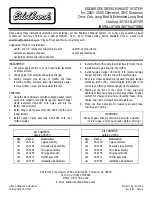
07 Wheels and tires
Vehicle loading
07
186
Loading the vehicle
Before loading your vehicle, familiarize yourself
with the following terms for determining your
vehicle's weight ratings, with or without a
trailer, from the vehicle's Federal/Canadian
Motor Vehicle Safety Standards (FMVSS/
CMVSS) label, and the vehicle's tire informa-
tion placard:
Curb weight
The weight of the vehicle including a full tank
of fuel and all standard equipment. It does not
include passengers, cargo, or optional equip-
ment.
Capacity weight
All weight added to the curb weight, including
cargo and optional equipment. When towing,
trailer hitch tongue load is also part of cargo
weight.
Permissible axle weight
The maximum allowable weight that can be
carried by a single axle (front or rear). These
numbers are shown on the Federal/Canadian
Motor Vehicle Safety Standards (FMVSS/
CMVSS) label. The total load on each axle must
never exceed its maximum permissible weight.
Gross vehicle weight (GVW)
The vehicle's curb cargo + passen-
gers.
NOTE
•
The location of the various labels in your
vehicle can be found on page 266.
•
A table listing important weight limits for
your vehicle can be found on page
269.
Steps for Determining Correct Load
Limit
1.
Locate the statement "the combined
weight of occupants and cargo should
never exceed XXX pounds" on your vehi-
cle's placard.
2.
Determine the combined weight of the
driver and passengers that will be riding in
your vehicle.
3.
Subtract the combined weight of the driver
and passengers from XXX kilograms or
XXX pounds.
4.
The resulting figure equals the available
amount of cargo and luggage load
capacity. For example, if the "XXX" amount
equals 1400 lbs. and there will be five
150 lbs. passengers in your vehicle, the
amount of available cargo and luggage
load capacity is 650 lbs. (1400–750 (5×150)
= 650 lbs.)
5.
Determine the combined weight of luggage
and cargo being loaded on the vehicle.
That weight may not safely exceed the
available cargo and luggage load capacity
calculated in Step 4.
WARNING
•
Exceeding the permissible axle weight,
gross vehicle weight, or any other
weight rating limits can cause tire over-
heating resulting in permanent defor-
mation or catastrophic failure.
•
Do not use replacement tires with lower
load carrying capacities than the tires
that were original equipment on the
vehicle because this will lower the vehi-
cle's GVW rating. Replacement tires
with a higher limit than the originals do
not increase the vehicle's GVW rating
limitations.
Содержание 2011 C30
Страница 1: ...VOLVO C30 Owner s manual Web Edition ...
Страница 2: ......
Страница 8: ...Contents 8 12 12 Index Index 280 ...
Страница 9: ...Contents 9 ...
Страница 17: ...01 SAFETY ...
Страница 49: ...01 Safety 01 49 ...
Страница 51: ...02 INSTRUMENTS AND CONTROLS ...
Страница 52: ...02 Instruments and controls Instrument overview 02 52 G019492 ...
Страница 89: ...02 Instruments and controls 02 89 ...
Страница 91: ...03 CLIMATE ...
Страница 102: ...G020908 102 Front seats 104 Interior lighting 112 Storage compartments 113 Rear seat 116 Cargo area 118 ...
Страница 103: ...04 INTERIOR ...
Страница 113: ...04 Interior Storage compartments 04 113 ...
Страница 121: ...04 Interior 04 121 ...
Страница 123: ...05 LOCKS AND ALARM ...
Страница 137: ...05 Locks and alarm 05 137 ...
Страница 139: ...06 STARTING AND DRIVING ...
Страница 173: ...06 Starting and driving 06 173 ...
Страница 175: ...07 WHEELS AND TIRES ...
Страница 201: ...07 Wheels and tires 07 201 ...
Страница 202: ...G020920 202 Washing and cleaning the car 204 Paint touch up 208 ...
Страница 203: ...08 CAR CARE ...
Страница 209: ...08 Car care 08 209 ...
Страница 211: ...09 MAINTENANCE AND SERVICING ...
Страница 239: ...10 AUDIO ...
Страница 263: ...10 Audio 10 263 ...
Страница 265: ...11 SPECIFICATIONS ...
Страница 266: ...11 Specifications Label information 11 266 ...
Страница 287: ......
Страница 288: ...Kdakd 8Vg 8dgedgVi dc IE JH6 8VcVYV 6I Eg ciZY c HlZYZc iZWdg 8deng i Kdakd 8Vg 8dgedgVi dc ...
















































